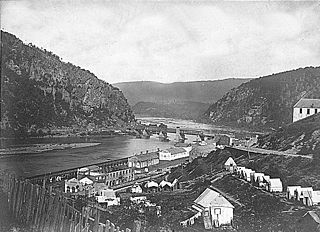
Funkstown is a town in Washington County, Maryland, United States. The population was 904 at the 2010 census.

The Battle of Five Forks was fought on April 1, 1865, southwest of Petersburg, Virginia, around the road junction of Five Forks, Dinwiddie County, at the end of the Siege of Petersburg, near the conclusion of the American Civil War.

The Battle of Monocacy was fought on July 9, 1864, about 6 miles (9.7 km) from Frederick, Maryland, as part of the Valley Campaigns of 1864 during the American Civil War. Confederate forces under Lt. Gen. Jubal A. Early defeated Union forces under Maj. Gen. Lew Wallace. The battle was part of Early's raid through the Shenandoah Valley and into Maryland in an attempt to divert Union forces from their siege of Gen. Robert E. Lee's army at Petersburg, Virginia.
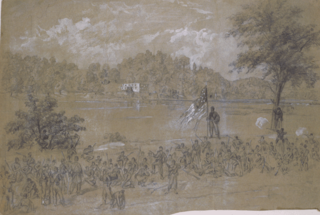
The Battle of Shepherdstown, also known as the Battle of Boteler's Ford, took place September 19–20, 1862, at Boteler's Ford along the Potomac River, during the Maryland campaign of the American Civil War. After the Battle of Antietam on September 17, General Robert E. Lee and the Confederate Army of Northern Virginia withdrew across the Potomac. Lee left a rear guard commanded by Brigadier General William N. Pendleton at Boteler's Ford. On September 19, elements of the Union V Corps dueled with Pendleton's artillery before pushing a short distance across the river at dusk. Pendleton inaccurately informed Lee that all of the artillery of the rear guard had been captured. On the morning of September 20, the Confederates counterattacked with A. P. Hill's Light Division, forcing the Union units back across the Potomac. One Union unit, the 118th Pennsylvania Infantry Regiment, did not withdraw at the same time as the others and suffered heavy losses. Lee's army continued its retreat into the Shenandoah Valley after the battle.

The Battle of Kelly's Ford, also known as the Battle of Kellysville or Kelleysville, took place on March 17, 1863, in Culpeper County, Virginia, as part of the cavalry operations along the Rappahannock River during the American Civil War. It set the stage for Brandy Station and other cavalry actions of the Gettysburg Campaign that summer. Twenty-one hundred troopers of Brig. Gen. William W. Averell's Union cavalry division crossed the Rappahannock to attack the Confederate cavalry that had been harassing them that winter. Brig. Gen. Fitzhugh Lee counterattacked with a brigade of about 800 men. After achieving a localized success, Union forces withdrew under pressure in late afternoon, without destroying Lee's cavalry.
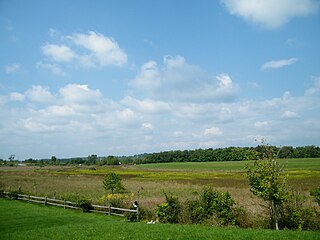
The Second Battle of Kernstown was fought on July 24, 1864, at Kernstown, Virginia, outside Winchester, Virginia, as part of the Valley Campaigns of 1864 in the American Civil War. The Confederate Army of the Valley under Lt. Gen. Jubal A. Early soundly defeated the Union Army of West Virginia under Brig. Gen. George Crook and drove it from the Shenandoah Valley back over the Potomac River into Maryland. As a result, Early was able to launch the Confederacy's last major raid into northern Union territory, attacking the Baltimore and Ohio Railroad in Maryland and West Virginia and burning Chambersburg, Pennsylvania, in retaliation for the burning of civilian houses and farms earlier in the campaign.
The Battle of Cool Spring, also known as Castleman's Ferry, Island Ford, Parker's Ford, and Snicker's Ferry, was a battle in the American Civil War fought July 17–18, 1864, in Clarke County, Virginia, as part of the Valley Campaigns of 1864. The battle was a Confederate victory.

The Appomattox campaign was a series of American Civil War battles fought March 29 – April 9, 1865, in Virginia that concluded with the surrender of Confederate General Robert E. Lee's Army of Northern Virginia to forces of the Union Army under the overall command of Lieutenant General Ulysses S. Grant, marking the effective end of the war.
The Battle of Crampton's Gap, or Battle of Burkittsville, was a battle fought between forces under Confederate Brig. Gen. Howell Cobb and Union Maj. Gen. William B. Franklin as part of the Battle of South Mountain on September 14, 1862, at Crampton's Gap in Western Maryland, during the Maryland Campaign of the American Civil War.

The Battle of Morton's Ford was a battle of the American Civil War, fought February 6–7, 1864.

John Randolph Chambliss Jr. was a career military officer, serving in the United States Army and then, during the American Civil War, in the Confederate States Army. A brigadier general of cavalry, Chambliss was killed in action during the Second Battle of Deep Bottom. He owned several slaves.
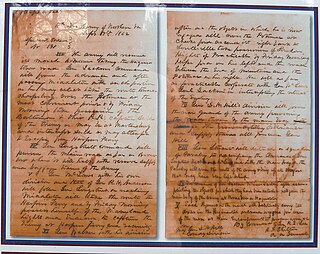
Special Order 191, also known as the "Lost Dispatch" and the "Lost Order", was a general movement order issued by Confederate Army General Robert E. Lee on about September 9, 1862, during the Maryland Campaign of the American Civil War. A lost copy of this order was recovered on September 13 by Union Army troops in Frederick County, Maryland, and the subsequent military intelligence gained by the Union played an important role in the Battle of South Mountain and Battle of Antietam.
Loudoun County, Virginia, was destined to be an area of significant military activity during the American Civil War. Located on Virginia's northern frontier, the Potomac River, Loudoun County became a borderland after Virginia's secession from the Union in early 1861. Loudoun County's numerous Potomac bridges, ferries and fords made it an ideal location for the Union and Confederate armies to cross into and out of Virginia. Likewise, the county's several gaps in the Blue Ridge Mountains that connected the Piedmont to the Shenandoah Valley and Winchester were of considerable strategic importance. The opposing armies would traverse the county several times throughout the war leading to several small battles, most notably the Battle of Ball's Bluff.

The Battle of Unison or Battle of Union refers to a series of American Civil War cavalry skirmishes in Loudoun County, Virginia, between October 31 – November 2, 1862, between the Confederate forces of J.E.B. Stuart and various units of the Union Army of the Potomac. Although driven from the field in individual engagements, Stuart accomplished his mission to delay the enemy and screen the movements of the retreating Army of Northern Virginia.
Heaton's Crossroads, also known as the Purcellville Wagon Raid, was an American Civil War skirmish that took place between Federal cavalry under Brig. Gen. Alfred N. Duffié and Confederate infantry under Maj. Gen. John C. Breckinridge on July 16, 1864, near present-day Purcellville, Virginia in Loudoun County as part of the Valley Campaigns of 1864. The action was tactically inconclusive.
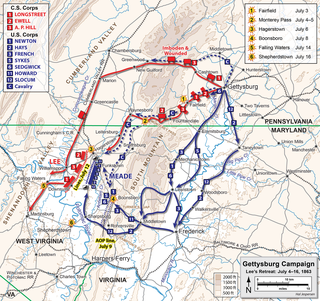
The Second Battle of Funkstown took place near Funkstown, Maryland, on July 10, 1863, during the Gettysburg Campaign of the American Civil War. Union forces of the Army of the Potomac attacked the rear guard of the Confederate Army of Northern Virginia during its retreat from Pennsylvania following the Battle of Gettysburg.

Beallsville is an unincorporated community in Montgomery County, Maryland, United States. It is a small community located north of Poolesville. The ZIP Code for Beallsville is 20839.
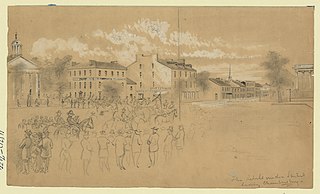
The Raid on Chambersburg, often identified as J.E.B. Stuart's Chambersburg Raid, was a Confederate States Army cavalry raid into Maryland and Pennsylvania on October 10–12, 1862 during the American Civil War. It became known as Stuart's "second ride around McClellan" because it duplicated Stuart's reconnaissance ride completely around the Union Army of the Potomac under Major General George B. McClellan during the ill-fated Peninsula Campaign.



